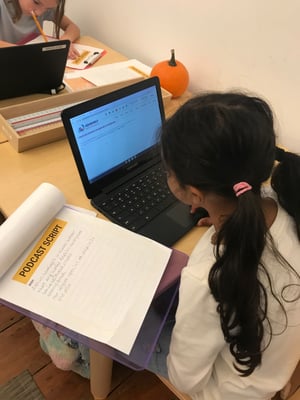
To become a strong writer, one must write a lot.
In the elementary studio, learners develop their writing skills by studying grammar in their grammar workbooks or using the online program NoRedInk, writing stories in their writing journals, writing book reports that focus on story elements, earning points in Vocabulary A-Z or completing spelling sets, and practicing their handwriting in print or cursive workbooks. They combine these skills and apply what they learn in Writer’s Workshop.
Each Writer’s Workshop focuses on a specific theme or genre and takes learners through the writing process, including the following steps:
- Prewriting: Learners research and brainstorm their topic.
- Drafting: Learners put their thoughts on paper in a coherent order.
- Editing/Revising: Learners participate in a community of editors and then make final edits and revisions to their own writing.
- Publishing: Learners share their pieces publicly.
One Writer's Workshop theme in the elementary studio is podcasts. To earn the Podcasts Badge, learners must create a podcast episode that is three to five minutes long (one to three minutes for first grade learners); includes an introduction, body, and conclusion; and is recorded and shared at the end of the session.
To kick off the most recent Podcasts workshop, learners spent time brainstorming and researching topics for their podcast. They were challenged to include at least three points about their topic. Learners chose a range of topics including horses, car mechanics, pizza, adventures, and football. One learner chose to write her podcast about her mom. She said, “I love my mom! She always helps me so I want to make my podcast for her as a surprise.”
After choosing a topic, learners began listening to an assortment of podcasts to get a feel for podcast formatting. Studio favorites included Weird But True!, a podcast by National Geographic that covers topics from bugs to natural disasters and includes two to three weird but true facts, and Unspookable, “a family friendly look at the histories and mysteries behind your favorite scary stories.” Learners used these example podcasts to help structure their own podcasts.
Learners also gave each other feedback on their podcasts using the warm-cool-warm format. Warm feedback is specific positive feedback. Cool feedback is specific feedback that can be used to raise a learner’s level of excellence. One learner offered this warm-cool-warm feedback combination, “I like how you used descriptive words. You should slow down a little bit when you’re speaking to be more clear. It’s a good idea to write out how hard words sound so you can say them easily when you record!”
Next, learners continue to draft, edit, and revise their work. Some learners were surprised to discover how much content they need to include for just a short, three-minute podcast. One learner said, “I’m up to two minutes, but I already have three pages of my script! This is the most I’ve ever written for Writer’s Workshop.”
Finally, learners recorded their podcasts and presented them to the group. One learner shared, “I’m feeling good about my podcast because I’ve added a lot of facts I think are interesting.” Learners enjoyed sharing their podcasts and hearing each other's recordings!